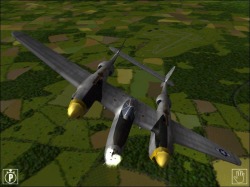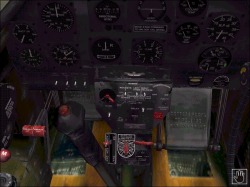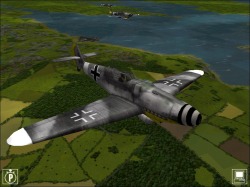By: Len 'Viking1' Hjalmarson
Date: 1999-11-30
B17 II: The Mighty Eighth is one of the most intriguing simulation designs of the decade. Just as Total Air War pushed the boundaries by combining a strategic AWACS simulation and a military flight simulation, so B17 II is pushing the boundaries of simulation gaming in a variety of areas.
Combining state-of-the-art graphics with first person play and motion capture crewmen, an online multiplayer game where up to ten humans can crew one heavy bomber, and a strong tactical dimension, B17 II is one of the most exciting simulation projects I've seen and looks likely to actually meet the high expectations that abound.
Our coverage to date has been extensive, rivalling only our pre-release coverage for Falcon 4.0. To view the previous interviews, screen shots and related articles go to our B17 Flying Fortress II Index.
Q. As more information became available on B17 II I realized that this was not a typical combat simulator, but closer to a true B17 simulator set in an active war. The scope of the simulation seems immense, crossing the lines between a "survey" type simulation and a focused simulation, and then melding state-of-the-art graphics and a first person shooter in the mix! With a project so ambitious, were you convinced from the start that this could be done, or were there moments of doubt?
A: B-17 II is first and foremost a flight simulator, and any additional aspects brought into the project were done so as to widen the experience in controlled ways. In this fashion it was possible to really put over a feel for how the war in the air looked, sounded and most of all felt to those who participated. Of course we've had to keep that focus to ensure nothing is lost or added that would threaten the core experience.

The scope of the simulator is large, but we feel that we have focussed carefully as well, so that the most important aspects of the 8th Airforce's Strategic bomber campaign are addressed and preserved. The crux of the plan for B-17 II was, from the start, to concentrate on those core experiences above all else and to find innovative new ways of approaching old problems, like good looking terrain that is both crisp and detailed, but non-repeating.
Project management in the industry has advanced to the point where risks are assessed intelligently at the beginning of any undertaking. Like any large project we've had our share of "unexpected" problems, but the big technology questions have been answered positively and the game's looking great, as you can see from the latest screenshots and movies - something to be really proud of.

Notice the variety of effects!
Q. How did you manage to assemble such a diverse team?
A: Both of the Directors, Dominic Robinson and Andrew Walrond have been in the industry for a long time, and have made many contacts along the way. They decided early on that to be successful, you have to be capable of producing the best games, that top 10% which generate all the sales and profit. This means in turn that you have to employ the best, most talented people you can get. So they put together a list of the best people they knew in the industry, and went shopping…
Q. The first person aspect will add immensely to the sense of immersion, but adds the complications of active crew management. Aside from dealing with the wounded, what is this like during an encounter with the enemy over the target area?

A: Well, we use First Person only where it adds to the gameplay. For example, crew management in first person would only serve to make the interface more complex and obscure. In cases such as flying the aircraft or manning the guns, first person is obviously more appropriate.
Over the target area you're likely to have kissed goodbye to the Luftwaffe interceptors, who'll be waiting for you to emerge from the areas of heaviest flak. Instead you'll be dealing with the tough issues needed to get the bombers over the target area. Although you aren't forced to adopt the role of the Bombardier, this is where the action is at during the bomb run so most players will be calibrating the sight with the correct wind drift and trying to visually identify the target in Search mode.

Fighter Dropping to Target
A: The first job is the setting up the bomb panel to ensure the aircraft is slaved to the autopilot, and that the correct racks are enabled, and that the bomb bay doors are open. The player will then position the cross hairs over the desired point of impact and use the analogue computer of the Norden to stop any lateral or horizontal drift away from his aim point. When the indices meet, that means that where the crosshairs are pointing is where the bombs will land. The player releases the bombs at the right time, and the rest of the formation bombs on him.
All the time the flak will be pounding away at the aircraft, perhaps causing damage or wounding crewmembers. The player will have to make quick calls on whether something is serious enough that he has to leave the Bombardiers position and deal with it, or whether he'll leave the AI crew to cope until after the critical release point.

Q. Tell us about the operation of the aircraft at different levels of realism when you're over the target area from the perspective of the pilot, navigator and bombardier.
A: WWII aircraft were easy to fly. They had to be, as most of the pilots were in their teens or early twenties, straight out of flying school. The B17 in particular is as docile an aircraft as you are ever likely to meet. The fighters less so, but still a lot easier than you might think after trying some other flight sims with the "realistic" flight model option.
We have only one level of flight model, realistic, and yet anyone can take-off, fly a mission and land successfully with a little practice. And yet all the detail is there. Try landing a B17 with number 1 dead and feathered in a cross wind, or a P51 with the fuselage tank full and the consequent rearward CofG, and you'll see what we mean!
For the navigator, the main areas of difficulty are in assessing and adjusting for wind drift, and not being able to see through cloud cover to fix your location. Both of these will be configurable. The bombardier encounters similar problems over the target.

Q. What is this like for the casual player? What about the hardcore player? I know that an important part of the design was to make the game accessible to as many gamers as possible, without diluting the content for hard-core flight-sim enthusiasts.
A: This involved implementing some of the most sophisticated AIs ever attempted in a game. It is possible, for instance, to play a whole mission as a gunner, and leave everything else to the AI pilots, navigators, bombardiers etc. You don't need to read an inch thick manual to play B17-2. You can start with the easier aspects, and learn the finer aspects of pilotage, navigation, bomb targeting etc. For instance, you can sit back, watch and listen as the AI pilot goes through the complex engine start-up sequence, before trying it for your self in a subsequent mission.
For the hardcore player, every switch, control, indicator is modelled in every aircraft. He can test the effect of starting with turbos on, having cowl flaps closed while taxing to the runway, leaving the air filters on at high altitude, leaving intercoolers hot for too long, forgetting to feather a dead engine…none of which are to be recommended!
Q. Have you actually tested yet with a number of human characters manning a single bomber? What was it like?
A: Groovy! But multi-player work is still in progress and won't be tested in hanger until after we hit Beta. Ask us again then !
Q. One of the big questions a few months ago involved the number of bombers we would see in a flight. Can you tell us where this stands at the moment?
A: We are currently testing with 12 B17's and similar sized squadrons of allied and German fighters. However, we're still in the process of optimising the engine and this will determine a sensible maximum number of aircraft in the air.
Q: Since the basic crew management is done on the ground prior to flight, what will we see the crew doing during the dull times on a long flight?
A: Each crewman randomly plays out one of a number of wait scenarios. For instance, the two gunners will engage in idle pranks with each other, kicking each other, knocking each other's caps off, and so on. You'll also see the navigator tapping his fingers and bobbing around in his seat listening to any radio stations he can pick up.
Q. Tell us about multiplayer features in general.
A: B-17 II has its server technology included, so people will be able to set up a server right out of the box, given the usual technical limitations like connection speed and bandwidth. The game gives players the ability to get together in the Quickstart, Historical Missions and the Campaigns. Depending on the mission the host chooses the players can quickly find themselves spread out amongst a squadron of B-17's, escort fighters and interceptor fighters.
Hosts have the ability to set the game up, and are granted the full powers of the single player in the single player game in addition to setting up the game environment. Thus they can plan missions to specific targets and repair bombers etcetera in the Squadron Commander campaign.
In game things will run exactly the same as in Single Player, with vacant roles being filled by AI's as normal. Active players can switch into and amongst any vacant role, according to the rules set up by the Server Host.

One of the big questions is how we're handling game balance in multiplayer and the way that's happening is that the number of planes of various types is fixed, with vacant slots being filled by AI's. If a player is being, say, a Luftwaffe pilot and he gets his Bf-109 shot out from under him then he CAN move to another Bf-109 controlled by the AI, provided one is vacant, and take control.
If, however, there are no vacant Bf-109's then he must spectate until there are - or take over a different role as the host allows. In this way the games balance is preserved. There will be no sudden influx of new Me-262's, unless the squadron flies within range of a base that can launch them.
Q. Will a player who has three computers in his home or office LAN need more than one CD to connect the machines?
A: This is something we're thinking over at this time. Certainly it will depend in part upon what resources are pulled from the CD in game amongst other issues. Ultimately though, it will be up to Microprose.